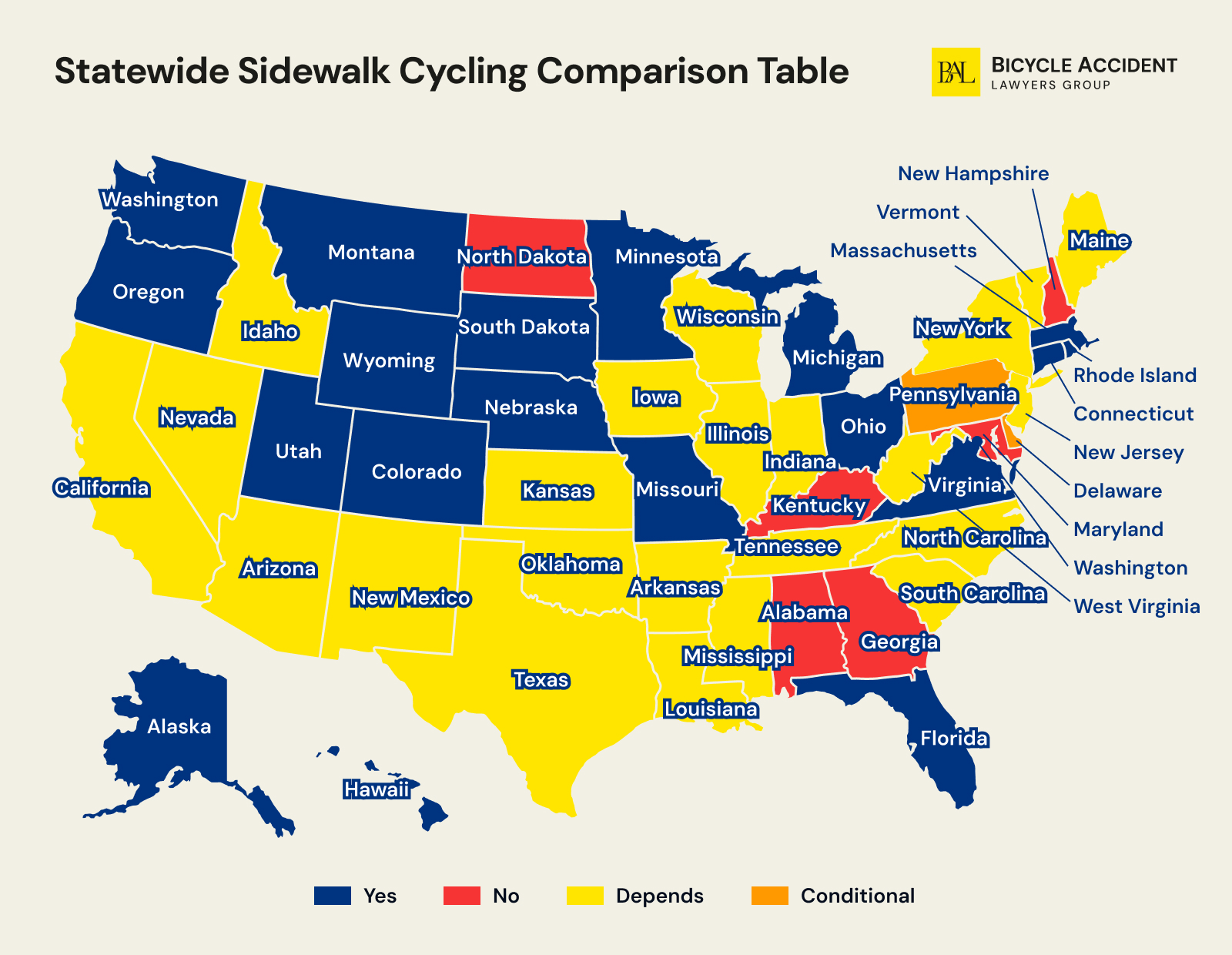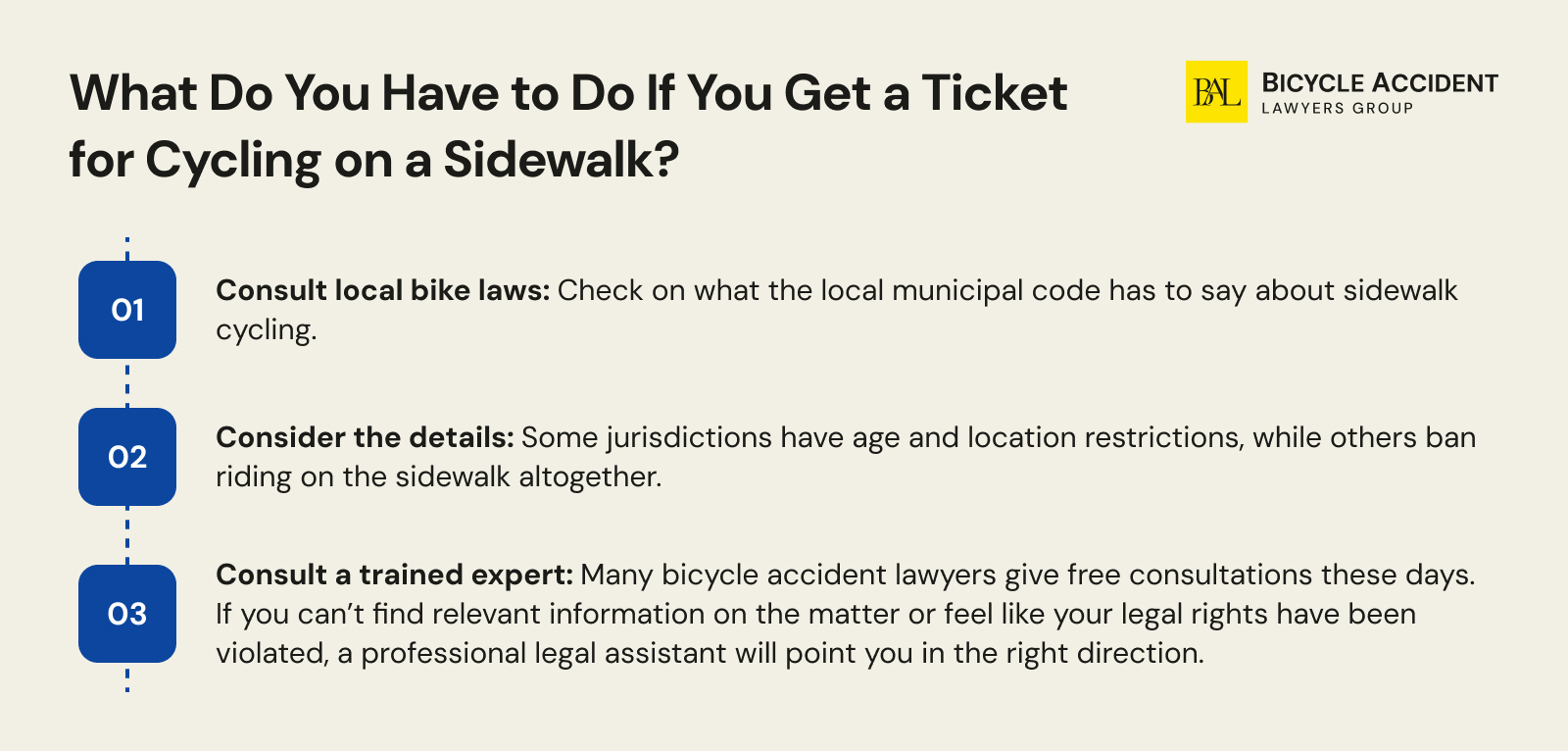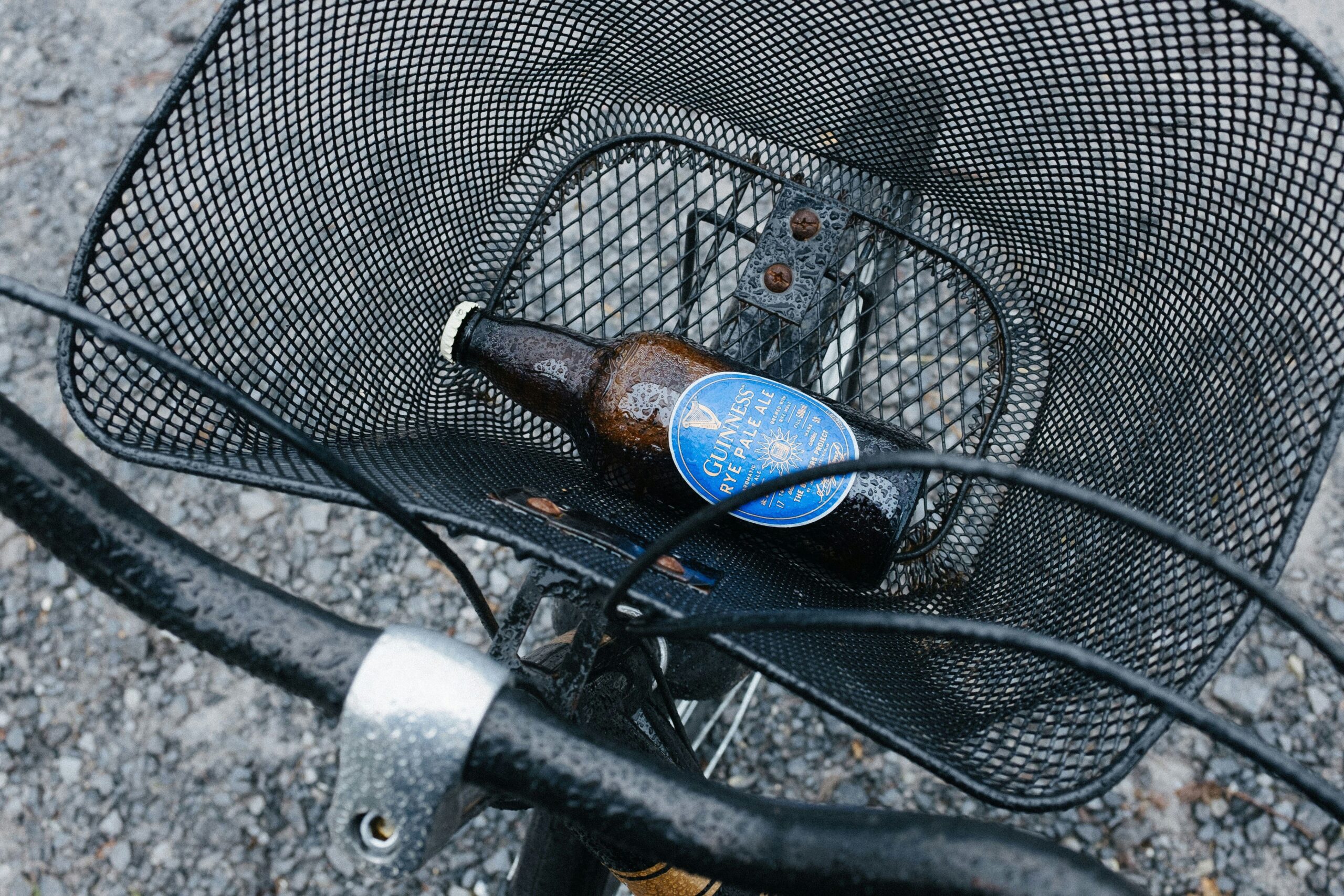Are bikes allowed on sidewalks? The ongoing debate about sidewalk riding in the USA hasn’t arrived at a one-for-all conclusion yet. While some states advocate for the additional safety that this practice can provide for such vulnerable road users as bicyclists, others remain adamant that it should be forbidden. At the same time, various states allow it to ride on a sidewalk under special circumstances.
Such an inconsistency of local laws requires that bike riders who want to enhance their protection on the road stay informed of their legal rights. Today, we’ll talk about how each state views the matter and how you can improve overall safety while cycling.
Key Takeaways
- 19 states of America deem it legal to bike on a sidewalk.
- Seven states in the USA consider sidewalk cycling illegal statewide.
- Local ordinances can override state laws.
- Violation of bike laws can result in a monetary penalty of up to $100.
Definition of a Sidewalk in the US
A sidewalk is a protected portion of a road on each side of it dedicated to foot traffic, for the most part. The main goal of a sidewalk is to eliminate traffic collisions between vulnerable road user categories and motor vehicles. There are different types of sidewalks you can come across in the USA.
However, most of them run parallel to the road and are marked accordingly. On top of general safety, sidewalks ensure that pedestrians, people with limited mobility needs, children, and bike riders can access any desired destination with ease and with decreased risk of injury. Many sidewalks are labeled as shared-use paths, which enable cyclists to exploit these routes as well.
Can You Be Fined for Sidewalk Riding?
Bike riders across most states of America are referred to as lawful road users, the same as motor vehicle drivers. That is why not only does a cyclist have to abide by existing traffic laws, but they can also be subject to a fine for violation of any of the state-approved regulations.
However, the situation differs from state to state, as well as from municipality to municipality. For example, in New York City, it is generally prohibited to ride on a sidewalk. If a bicyclist disobeys the rule, they will receive a fine up to $100, a 20-day of imprisonment, or a combination of both.
Sidewalk Riding: To Ride or Not to Ride

One size does not fit all. That is the most realistic description of statewide laws in the country when it comes to bike riders using sidewalks. Even if the state law proclaims it either legal or illegal to use a sidewalk as a designated bike lane, local ordinances have the right to enforce regional regulations that contradict it.
Moreover, various safety concerns, traffic volumes, and other conditions may force the local authorities to accept stricter laws and even bans to improve the safety statistics in the area.
The primary reason why a committed cyclist must know local laws is to ensure personal well-being and avoid fines and legal consequences of a potential bicycle accident. Are you ready to learn how each state regards sidewalk cycling?
Alabama
The NHTSA research indicated that only 14% of all bicycle trips were recorded on sidewalks. The stats may seem quite surprising until you come across such specific rules as those of the state of Alabama. According to state law, bikes are considered vehicles. That is why riding bicycles on sidewalks is banned across the state.
Alaska
Unlike in Alabama, you can bike on a sidewalk in Alaska. However, there are a few conditions to ensure:
- A cyclist must ride carefully to avoid any collisions with pedestrians and other sidewalk users.
- Bicyclists owe the right of way to pedestrians.
- A bike rider must give an audible signal before overtaking another person.
Arizona
Arizona is one of those states that does not have strict regulations that apply to sidewalk riding per se. However, state authorities allow local governments to administer their own rules for the practice. That is why you may want to consult local ordinances before you go on a ride in Arizona. They will help you steer clear of risky situations and provide necessary insight into the steps to take after a bicycle accident should it occur.
Arkansas
Arkansas laws don’t prohibit riding on a sidewalk in general, but they also don’t recommend it. The fact is that sidewalk cycling is twice as likely to result in a serious collision with a motor vehicle, especially at the intersection. It is important to note that some cities in Arkansas can abide by stricter laws. For example, it is banned to ride on a sidewalk in Hot Springs, Little Rock, and Maumelle.
California
The state of California chose to let each municipality decide whether or not they allow it to ride on sidewalks. This means that it is vital to check with local ordinances regarding where you can and can’t ride. In LA, cyclists are allowed to use sidewalks as long as they give audible signals and right of way to pedestrians when needed. At the same time, local laws in Carlsbad, Escondido, Vista, and some other cities ban bike riders from sidewalks.
Colorado
Bikes, electric bicycles, and other human-powered vehicles are allowed on the sidewalks of Colorado. However, there are a few specific circumstances to keep in mind when cycling in the state. It is mandatory to get off the vehicle in special Dismount Zones, avoid cycling in areas prohibited by traffic control devices, and give pedestrians the right of way.
Connecticut
Generally, bike riders in Connecticut can use sidewalks to get from one destination to another. However, they should alert those on foot about their presence from a safe distance so that the pedestrian can react in time and avoid an unfortunate incident. Besides, when you ride on the sidewalk in Connecticut, you have to follow the same crosswalk signals as pedestrians.
Delaware
Delaware cyclists are safe to bike on the sidewalk under three major conditions:
- There is no bike lane in the vicinity.
- It isn’t a business district.
- There are no signs or devices that prohibit the activity.
Washington, DC
The District of Columbia has one major law when it comes to riding a bike on the sidewalk — you can do it anywhere except the Central Business District. The rule does not apply to the specially designed bicycle sidewalks in the area. Other than that, as long as bike riders abide by general traffic laws, they are safe to exploit local sidewalks.
Florida
Although the state of Florida primarily treats bicycles as full-on motor vehicles, cyclists are generally allowed on sidewalks. Except for some restricted areas, which are defined by local ordinances. Despite favorable sidewalk riding rules, bike riders must be exceptionally careful when navigating the streets of Florida since the bicyclist fatality rate in the state is alarmingly high — 6.3% of all traffic deaths.
Georgia
The state law of Georgia treats bicycles as vehicles at all times. This means that cyclists can’t use local sidewalks to navigate the streets. Children of 12 and under make the only exception to the rule.
Hawaii
Considering the free-spirited and inviting nature of the state, bikers are allowed to ride on the sidewalk in Hawaii. You can access almost any part of the state on a bicycle using a sidewalk, except for business districts. Also, it is mandatory to ride at a state-approved speed – no more than 10 mph.
Idaho
One can ride on the sidewalk in Idaho unless the local ordinance forbids such an activity. Bike riders have the same rights as pedestrians, except that the former owes the right of way to the latter and has to warn people on the sidewalk about their presence.
Illinois
The state of Illinois forbids any vehicle on the sidewalk other than one that is moved by human power, that is, a bicycle. However, every county and city may have special exceptions to the rule to follow. For instance, in Chicago, you can’t use a sidewalk unless it is marked as a designated bike path, or you are heading to the nearest bike station.
Indiana
Indiana is yet another state that leaves it to the local government to decide whether or not you can bike on a sidewalk. For example, in Indianapolis, kids under 12 years old can use the sidewalk while adult riders are prohibited from doing so. So, it is vital to brush through local laws to know where you stand with sidewalk cycling in Indiana.
Iowa
The state law of Iowa claims that local ordinances are responsible for the rules and regulations they apply to improve general road safety. That is why, in Cedar Rapids, a cyclist can’t ride on a sidewalk in the central business district as well as on the path where “No sidewalk riding” signs are posted.
Kansas
The state law of Kansas does not declare whether or not one can ride on sidewalks in the area. Local governments are the ones to impose corresponding regulations. That is why, in Wichita, you can use a sidewalk as long as the posted signs do not indicate otherwise. Besides, you should always give pedestrians the right of way.
Kentucky
In Kentucky, bike riders primarily have the same rights as pedestrians under the same circumstances. However, some local ordinances have their own vision of sidewalk cycling. Thus, in Louisville, no bicyclists older than 11 years old are allowed on the sidewalk.
Louisiana
One could call Louisiana one of the gray states when it comes to sidewalk riding. The fact is, state law neither allows nor prohibits sidewalk cycling. Local municipalities take full responsibility for the corresponding regulations. For example, in New Orleans, only cyclists under 15 years old can use the sidewalk for the aforementioned purpose.
Maine
Maine belongs to the same group of gray states when it comes to biking on a sidewalk. There are no existing state laws that attend to the matter. That is why you mustn’t go for a ride in the area without checking the local laws. Not knowing the rules does not rid you of responsibility.
Maryland
State law regarding sidewalk riding in Maryland seems quite simple — no bicycles are allowed on the sidewalk. However, there are local exceptions that hardly make a logical pattern. For instance, in Montgomery County, you can bike on a sidewalk unless you are cycling in the City of Gaithersburg, where it is absolutely prohibited. Summing up, you should always leaf through local bike laws to figure out whether you should or shouldn’t ride on sidewalks in the area.
Massachusetts
Massachusetts authorities deem it legal to ride on sidewalks in the state. There may be areas that can’t be accessed on a bicycle, but there will be signs indicating the restriction. Cyclists in Massachusetts have to give the right of way to pedestrians while biking on sidewalks. Keep in mind local ordinances, such as those of Boston, that pay increased attention to bicyclist safety. Thus, they encourage cyclists to use designated bike lanes where possible.
Michigan
It is allowed to bike on the sidewalk in Michigan as long as the cyclist warns those on foot about their presence and gives them the right of way when required. There may be certain exceptions that come from local ordinances, so it is always a good idea to check out local regulations first.
Minnesota
Bicyclists in Minnesota are allowed but not recommended to bike on the sidewalk. The primary reason is the overall concern about both cyclists’ and pedestrians’ safety. Usually, the travel speed of a vehicle exceeds that of a person on foot, thus posing palpable danger should a collision take place.
Mississippi
The state law of Mississippi does not provide a strict regulation for sidewalk cycling. This means that local jurisdictions dictate the rule. So, in Jackson and Gulfport, you can bike on the sidewalk as long as it is outside a business district. At the same time, the cities of Starkville and Hattiesburg forbid biking on sidewalks.
Missouri
Missouri statutes claim that riding in the same direction as the rest of the traffic is safer than riding on the sidewalk, but they do not prohibit the practice. You can bike on the sidewalk outside of business districts. However, the rule applies to regular bicycles. E-bikes are banned from sidewalks.
Montana
The state of Montana stresses the importance of the safe and peaceful coexistence of different groups of road users. This means that bike riders are allowed on public pathways such as sidewalks. However, there may be different local restrictions, like in Billings, that prohibit cycling in business districts or other areas.
Nebraska
In Nebraska, it is legal to ride a bicycle on crosswalks and sidewalks. Moreover, cyclists possess the same rights and duties as pedestrians, yet the former owe a duty of care to the latter. Fun fact: according to the latest bicycle accident statistics, the state saw zero cyclist fatalities.
Nevada
Nevada does not have specific bike laws that regulate sidewalk riding in the area. The local government imposes preferred regulations aimed at improving the safety situation in the area. That is why, in Las Vegas, certain streets are off-limits for cyclists.
New Hampshire
In New Hampshire, bike riders are prohibited from using sidewalks since bicycles are viewed as full-on vehicles, according to state law. However, children under 16 who aren’t legal operators can bike on the sidewalks in the area.
New Jersey
New Jersey statutes do not prohibit cycling on a sidewalk in general. However, that does not mean that all local municipalities allow it. In fact, most densely populated areas, such as shore towns, ban the practice, with the exception of small kids biking under parental supervision.
New Mexico
There isn’t a precise state law that outlines sidewalk cycling as a practice that is either allowed or forbidden. Mainly, it is delegated to local authorities to decide how to handle the situation. Thus, the Albuquerque City Code states that bike riders can’t use a sidewalk when there’s a dedicated bike lane available.
New York
While the state of New York does not have precise rules and regulations that apply to riding on a sidewalk, local municipalities do. For example, in the city of Elmira, only children under 14 years old are allowed on sidewalks. In the cities of New York and Ithaca, the requirements are even stricter, and kids of 12 years and under and of 10 years old and under are the only cyclists to bike on the sidewalk.
North Carolina
There aren’t any statewide laws referring to riding on a sidewalk in North Carolina. This means that local governments are entitled to come up with specific regulations they deem necessary, considering the situation in the area. For example, in Raleigh, cyclists are permitted to bike on the sidewalk as long as they comply with existing traffic regulations.
North Dakota
According to the state law of North Dakota, cyclists aren’t permitted to ride on the sidewalk, because they are classified as vehicles. No local laws can overrule the regulation. However, state statutes do not regulate where to ride when it comes to choosing between bike lanes and shared roads — it is left to the bicyclists to decide.
Ohio
It is legal to bike on the sidewalk in Ohio. However, the state gave local municipalities the power to alter the regulations. That is why, in Cincinnati, mainly those who are 15 years old and under can cycle using sidewalks legally. The rest may look for joint sidewalks. These routes have special signs indicating that both bike riders and pedestrians can use the path.
Oklahoma
There isn’t a general statewide rule in Oklahoma that regulates sidewalk riding in the area. That is why laws on sidewalk cycling vary from municipality to municipality. For instance, in Oklahoma City, bicycle laws ban riders from business districts while the rest of the city is okay to navigate on a sidewalk.
Oregon
Bike laws in Oregon permit riders on the sidewalk. However, there’s a list of requirements that cyclists have to comply with to avoid potential repercussions. They are the following:
- Notify pedestrians about their presence with an audible signal.
- Ride at a walking speed.
- Operate the vehicle with caution to avoid creating potentially dangerous situations.
Pennsylvania
The state of Pennsylvania allows sidewalks to be used as bike paths anywhere except for business districts. This policy is subject to the requirement that cyclists adhere to the current traffic laws and yield the right of way when passing pedestrians. However, some jurisdictions may proclaim alternative regulations that a biker must learn about before going for a ride in the area.
Rhode Island
Rhode Island is a bicycle-friendly state that deems sidewalk cycling legal. State law grants bicyclists the same rights as pedestrians on sidewalks. However, bike riders must fulfill the same legal duties. Noncompliance with the duties may affect your compensation if you get into an accident on the sidewalk. In case you or your loved one have been involved in a similar incident, you can use an online bicycle accident settlement calculator to determine the approximate worth of your claim.
South Carolina
In South Carolina, local municipalities have the right to allow or ban riding on a sidewalk since there are no state laws regarding this matter. Thus, in Charlestown, only kids aged 12 and under can use the sidewalks.
South Dakota
It is absolutely legal to bike on the sidewalk across South Dakota. Yet, bike riders should not forget about their duty of care when doing so. Pedestrians hold the absolute right of way, and cyclists must remember that.
Tennessee
Tennessee bicycle laws aren’t specific about such practices as riding on a sidewalk. So, it is safe to assume that you can bike on the sidewalk in the area. However, some jurisdictions may have location-specific requirements, and it is best to consult those before going on a sidewalk trip somewhere in the state.
Texas
The state of Texas does not prohibit riding on the sidewalk, per se. However, large cities and counties have laws that attend to the matter. Usually, there are certain sidewalks to avoid, especially in business districts and city centers. You should contact local law enforcement to learn more about cycling conditions in the area.
Utah
The state law of Utah grants cyclists the right to bike on the sidewalk as long as it does not obstruct foot traffic in the area. Certain zones and districts are off-limits for bicyclists across the state. Usually, these areas are marked by clear signs indicating that a rider has to dismount or use available bicycle paths to continue.
Vermont
Electric bikes are strictly banned from local sidewalks since they are viewed as motorized vehicles. The law does not directly affect regular bicycles, but local regulations may come into effect. For example, some major commercial areas or business districts may be off-limits for riders.
Virginia
Virginia is yet another state that allows one to bike on the sidewalk. However, major cities and counties in the state have additional rules and regulations when it comes to the subject. For example, you can use a sidewalk in Virginia Beach anywhere except for the Oceanfront. In Norfolk, you aren’t permitted to ride on the sidewalk if there are specially equipped bicycle paths nearby.
Washington
In Washington, state law approves the use of bicycles on sidewalks. Riders in the state have the same rights and duties as pedestrians while on a sidewalk and acquire the rights and duties of motor vehicle operators after leaving the zone.
West Virginia
There isn’t a one-for-all rule to abide by when it comes to sidewalk riding in West Virginia. Every jurisdiction has the right to impose local laws that control the situation in the area. For instance, in Parkersburg, no one is allowed to bike on the sidewalk in business districts, while only children under 12 years old can ride those across other parts of the city.
Wisconsin
It is forbidden to ride on the sidewalk in Wisconsin for anyone past their learning stage. However, each community is allowed to pass an ordinance to overrule the ban and allow sidewalk cycling on the local level. You should always check for age or location restrictions intact.
Wyoming
Human-powered vehicles are allowed on sidewalks in Wyoming, meaning that you can bike on the sidewalk in the state as long as local ordinances do not state otherwise. In Jackson, cyclists are prohibited from riding on sidewalks within a two-block radius of the Town Square.
Statewide Sidewalk Cycling Comparison Table
Every state has a different view on sidewalk riding. Some states deem it straight off illegal, while others consider that the practice can improve the overall cycling safety in the area. Surely, there are always local ordinances in place that have the final say in the matter.
| State | Is sidewalk cycling allowed? | Notes |
| Alabama | No | Bicycles are considered vehicles. |
| Alaska | Yes | Cyclists must always yield to pedestrians |
| Arizona | Depends | Local ordinances determine the regulations. |
| Arkansas | Depends | Local ordinances apply. |
| California | Depends | Each local municipality individually decides whether to grant the right to ride on sidewalks. |
| Colorado | Yes | It is obligatory to check for Dismount Zones |
| Connecticut | Yes | Local governments have the right to overrule state bike laws. |
| Delaware | Conditional | It is allowed to use sidewalks if there are no bike lanes available. |
| Washington, DC | Yes | Sidewalk cycling is strictly forbidden in the Central Business District. |
| Florida | Yes | Pedestrians have the right of way. |
| Georgia | No | The laws do not apply to children of 12 and under. |
| Hawaii | Yes | It is prohibited to bike on the sidewalk, exceeding the 10 mph speed limit. |
| Idaho | Depends | Local ordinances impose their permits and restrictions. |
| Illinois | Depends | Local authorities determine cycling rules in the area. |
| Indiana | Depends | Local governments choose how to treat bike riders on sidewalks. |
| Iowa | Depends | Local municipalities decide on specific terms when it comes to sidewalk cycling. |
| Kansas | Depends | Local laws apply. |
| Kentucky | No | Biking on the sidewalk is prohibited. |
| Louisiana | Depends | Local regulations apply. |
| Maine | Depends | Checking local bike laws is mandatory. |
| Maryland | No | Local municipalities have the rule to override state restrictions. |
| Massachusetts | Yes | It is advised to use bike lanes instead. |
| Michigan | Yes | Pedestrians on sidewalks always come first. |
| Minnesota | Yes | Allowed but recommended to use bike lanes instead. |
| Mississippi | Depends | Local jurisdictional rules apply. |
| Missouri | Yes | It is recommended to use a bike lane or share the road with the rest of the traffic. |
| Montana | Yes | Local restrictions exist. |
| Nebraska | Yes | Some local jurisdictions make exceptions and prohibit sidewalk cycling. |
| Nevada | Depends | Certain sidewalks are inaccessible for cyclists. |
| New Hampshire | No | Only kids under 16 can ride on sidewalks in the state. |
| New Jersey | Depends | The practice is banned in largely populated areas. |
| New Mexico | Depends | Every local jurisdiction specifies sidewalk cycling requirements and regulations. |
| New York | Depends | Rules between municipalities vary drastically. |
| North Carolina | Depends | Local ordinances define the sidewalk cycling situation in specific areas. |
| North Dakota | No | Cyclists aren’t permitted to use sidewalks. |
| Ohio | Yes | Local governments have the authority to overrule the state permit.
|
| Oklahoma | Depends | Local authorities decide on specific bike laws in the area. |
| Oregon | Yes | Cyclists are allowed on sidewalks under specific conditions. |
| Pennsylvania | Conditional | Local jurisdictions can overrule statewide permits. |
| Rhode Island | Yes | Bike riders are allowed to use sidewalks and share the same rights and duties as pedestrians. |
| South Carolina | Depends | There are no statewide regulations intact. Local ordinances predefine bike laws to abide by. |
| South Dakota | Yes | Bicyclists are granted the same rights and obligations as pedestrians while on the sidewalk. |
| Tennessee | Depends | Statewide regulations do not apply to sidewalk cycling. You must consult local ordinances. |
| Texas | Depends | Local bicycle laws, especially in large cities, define sidewalk riding laws in the vicinity. |
| Utah | Yes | Sidewalk cycling is permitted, but local restrictions may apply. |
| Vermont | Depends | There isn’t a direct prohibition of sidewalk riding in the state, but local ordinances may overrun it. |
| Virginia | Yes | Sidewalk riding is legal, but local changes apply. |
| Washington | Yes | Cyclists are referred to as pedestrians when biking on a sidewalk. |
| West Virginia | Depends | Bike riders must comply with local ordinances. |
| Wisconsin | Depends | Local governments have the power to overrule the state law. |
| Wyoming | Yes | Sidewalk cycling is legal, although it is discouraged. |
What Do You Have to Do If You Get a Ticket for Cycling on a Sidewalk?

Every situation is different since local cycling laws vary drastically when it comes to sidewalk riding. However, there are a few simple steps to take to protect your rights:
- Consult local bike laws: Check on what the local municipal code has to say about sidewalk cycling.
- Consider the details: Some jurisdictions have age and location restrictions, while others ban riding on the sidewalk altogether.
- Consult a trained expert: Many bicycle accident lawyers give free consultations these days. If you can’t find relevant information on the matter or feel like your legal rights have been violated, a professional legal assistant will point you in the right direction.
Finally, if you were lawfully fined, the best thing to do would be to pay the ticket.
Conclusion
Bicycle laws across the country are as numerous and versatile as the states themselves. Today, we’ve discussed the statewide views on sidewalk cycling across the USA. This knowledge may help you discover new horizons, biking throughout America legally, responsibly, and safely. However, every adventurer needs a reliable ally on the journey. Bicycle Accident Lawyers Groups is your go-to team if you have any questions on cycling laws. All it takes is to contact our team for free when you need it, and we’ll provide the advice and assistance you seek!






